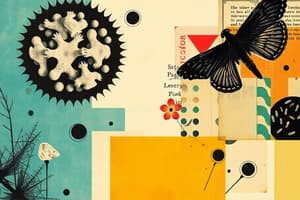Podcast
Questions and Answers
What is the primary reason that food serves as a substrate for microbial growth?
What is the primary reason that food serves as a substrate for microbial growth?
- Food is a sterile environment that allows microbes to colonize without competition.
- Food contains the necessary nutrients that microbes require for survival and reproduction. (correct)
- Food provides a diverse ecosystem for microbes to thrive in.
- Food is a complex organic matter that is easily biodegraded by microorganisms.
Which of the following microbial groups are commonly found in food ecosystems?
Which of the following microbial groups are commonly found in food ecosystems?
- Bacteria and viruses
- Protozoa and archaea
- Yeasts and molds (correct)
- All of the above
What is the primary consequence of the biodegradation of food by microorganisms?
What is the primary consequence of the biodegradation of food by microorganisms?
- Spoilage and food waste (correct)
- Increased nutritional value of food
- Improved food preservation
- Enhanced flavor and aroma of food
Which of the following is NOT considered a source of food contamination?
Which of the following is NOT considered a source of food contamination?
What is the primary role of microbes in the production and preservation of fermented foods?
What is the primary role of microbes in the production and preservation of fermented foods?
Which of the following is the most important factor in determining the diversity of microbes found within a food ecosystem?
Which of the following is the most important factor in determining the diversity of microbes found within a food ecosystem?
What is one of the potential consequences of improper handling and storage temperatures in food?
What is one of the potential consequences of improper handling and storage temperatures in food?
Which of the following is NOT listed as a source of cross-contamination that can affect food safety?
Which of the following is NOT listed as a source of cross-contamination that can affect food safety?
What type of practices involving water and ice can introduce contaminants to the food supply if done incorrectly?
What type of practices involving water and ice can introduce contaminants to the food supply if done incorrectly?
Why is preventing contamination while utilizing microbes for food purposes considered a delicate balance?
Why is preventing contamination while utilizing microbes for food purposes considered a delicate balance?
Which of the following is NOT a factor that can contribute to microbial growth in food?
Which of the following is NOT a factor that can contribute to microbial growth in food?
Flashcards are hidden until you start studying
Study Notes
Food and Microbes: A Closer Look at Food's Substrate and Contamination Sources
Food as a Substrate for Microbial Growth
Understanding how food serves as a substrate for microbial growth requires first delving into what constitutes a substrate. Simply put, a substrate is the material or substance upon which something grows, thrives, or acts. When it comes to food, several key points emerge:
-
Nutrition: Microbes require specific nutrients to survive and reproduce. Various fruits, vegetables, grains, and animal products offer a wealth of essential elements that serve as substrates for countless microbial species.
-
Ecosystem: The diversity of microbes found within food ecosystems is vast. Yeasts and molds are among the most common groups, contributing significantly to fermented foods and play an integral role in food production and preservation.
-
Biodegradation: Food, particularly complex organic matter, offers abundant opportunities for biodegradation. This process involves the breakdown of organic matter by microorganisms, which can lead to spoilage and food waste if not managed properly.
Sources of Food Contamination
As with any dynamic ecosystem, understanding food and its relationship to microbes also involves examining the factors that contribute to contamination. These sources can broadly be categorized as follows:
-
Temperature: Improper handling and storage temperatures can create ideal conditions for bacterial and fungal growth, leading to spoilage and contamination of the food supply.
-
Contamination Pathways: Sources of cross-contamination include kitchen utensils, raw meat, environmental surfaces, and personal contact.
-
Processing and Preservation Practices: Techniques that rely heavily on the use of water and ice, such as cold storage and washing, can potentially introduce contaminants if performed improperly.
Since food microbiology encompasses both beneficial and detrimental aspects of microbes in relation to food production, prevention of contamination while promoting utilization of microbes for food purposes is a delicate balance that requires careful consideration.
Studying That Suits You
Use AI to generate personalized quizzes and flashcards to suit your learning preferences.




